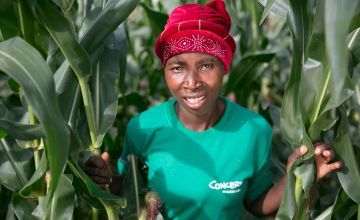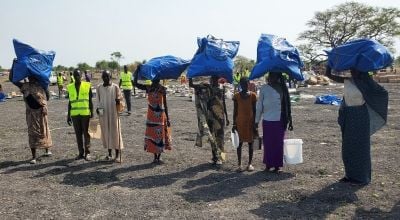
Read our 2024 annual report

Knowledge Hub
The COVID-19 pandemic has set back progress towards the United Nations Sustainable Development Goal of Zero Hunger by 2030. The 2021 Global Hunger Index shows that the world as a whole — and 47 countries in particular — will fail to achieve even low hunger within the next nine years. However, not everything you hear about global hunger is true. Here, we correct a few of the most persistent hunger myths, and offer up a few facts to know in 2022.
Myth: There simply isn’t enough food to feed the world’s growing population
While world hunger has many linked causes, a global shortage of food is not one of them. Organisations such as the UN’s World Food Programme have proven that the world already produces enough food to feed up to 10 billion people (which will be the expected global population by 2050). Food production continues to increase faster than population growth. However, as many as 811 million people faced hunger in 2020.
Fact: Broken food systems prevent people from getting the nutrition they need
If the world produces enough food to feed its entire population, then why do approximately 1 in 9 people go hungry? Broadly speaking, it’s because the food systems in areas with high levels of hunger and food insecurity are broken. Simply put, a food system is the cycle in which food is produced and prepared for people to then buy, cook, and eat. Food waste, poor infrastructure, ineffective governance and social services, climate change, and conflict are all potential interruptions to a food system, and once the cycle breaks in an area, it can be incredibly difficult to repair — especially when it means not only ensuring that people have food today, but also the means of having enough food every day.

Myth: Ending hunger simply means ensuring that people have enough to eat
Hunger is not just about having enough food; it also involves having the right balance in the type of food we eat so that we get the right combination of nutrients and calories needed for healthy growth and development. A lack of this is often referred to as ‘hidden hunger,’ and it can be especially harmful for pregnant and lactating women and their young children.
Fact: Sometimes there’s enough food in an area, but people still can’t access it
This is another key global hunger myth: Hunger can happen in a community where plenty of food is available. We’ve seen this happen in light of COVID-19-related job and livelihood losses, as well as in countries with rapidly-rising inflation rates or where conflict and insecurity keep people from leaving home. People in a community may not be able to afford even the most basic staples available to them if they can’t afford it or get to the market. This is one of the reasons that cash transfers and vouchers are key ingredients to ending hunger — they allow people to get the food they need, and help to stimulate their local economy and support their friends and neighbours’ small farms or shops.

Myth: Hunger is caused by natural disasters and is therefore beyond our control
While natural disasters contribute to hunger levels, food is always available to those who can afford it. Millions of the world’s economically poorest and most vulnerable to shocks live on the edge with little to no surplus in case of an emergency. Inequality, poverty, conflict, and the economic and political behaviour of those in power place larger numbers at environmental risk every year. Blaming nature for this simply avoids the real issues.
Fact: High-income countries must honour their commitments to climate justice
Climate change is one of the biggest contributors to hunger rates today. Climate change is also a man-made phenomenon. The effects of climate change on our global food systems cannot be reversed. High-income countries have committed to foreign assistance; the Paris Climate Agreement, and other initiatives aim to correct the imbalance of climate justice between countries responsible for the crisis and countries suffering the worst of its impacts. Many governments, however, have fallen short of their pledged funds and actions, and should be held to account for honouring those commitments.

Myth: We can’t predict when and where a food crisis will hit
We now know who those at risk of hunger are: small landholders, agricultural labourers, many indigenous peoples (especially farmers), and the urban poor. We also know a lot about when people are likely to be hungry: in the ‘hungry months’ before a harvest, when food from the previous harvest has run out, when smallholder farmers have to sell off their basic tools, seeds, or livestock in order to buy food, and when food prices rise on world markets (to name a few).
Our famine early warning systems are now much improved, such as research into early detection of plant diseases using smartphone technology. This information (which is rapidly improving all the time) allows us to plan ahead, be prepared with effective strategies and to focus on those most at risk.
Fact: We can plan for — and even prevent — hungry seasons, food crises, and famine
Traditional aid models have, often by necessity, relied on certainty. But in emergency contexts, this doesn’t always work. Waiting for the full picture of need and risk to develop can waste precious time, and leave civilians to pay the ultimate price. Breaking with tradition, Concern adopted an approach to emergencies called Early Warning, Early Action (EWEA). Instead of responding to an emergency based on certainty, we began responding (proportionately) to the probability of a disaster. In some cases, this meant that we responded early to the signs of a crisis that didn’t come to pass. But, in the long term, EWEA still saves money: An ounce of prevention is worth a pound of cure.
This is especially true when a potential emergency could also lead to increasing hunger and malnutrition rates. In January of 2017, Somalia’s leading source on food security indicated the possibility of a famine. By that time, a Building Resilient Communities in Somalia — Concern programme with EWEA as its foundation — had been active for seven months. Somalia avoided a famine that year, in part due to the early responses to these warning signs.
Myth: Hunger is simply a public health issue, and there are many other pressing issues that we also have to focus on in the world
As humanitarian writer and activist, Alex de Waal writes:
“Food security is not only an essential component of human well-being but also a foundation for political stability.”
Hunger is an intersectional issue that affects many of the other areas in which Concern works: One recent study for the Copenhagen Consensus on Human Challenges suggests that well-nourished children are 33% more likely to escape poverty as adults, and there are numerous other studies linking lower hunger rates to higher levels of both personal and gross national incomes. Hunger is also linked with conflict, lower education rates, poor maternal and child health, and higher rates of inequality and marginalisation. Addressing this issue will help to offset a number of other risks towards ending extreme poverty and creating a more sustainable and just world.
Fact: Hunger rates are rising again, but the situation isn’t completely hopeless
The percentage of people experiencing undernourishment and other hunger-related issues has declined in all regions of the world since 1991. There are now some 220 million fewer hungry people than in 1990-92, despite a 1.9 billion increase in the world’s population.
Yes, the number of the world’s hungry has begun to rise again since 2014, particularly in sub-Saharan Africa and Asia. However, we now know far more about the issue of hunger, its causes, those at the greatest risk, and about how best to intervene. We’re better-equipped than ever before to tackle the issue.
If we seriously choose to do so. One of the biggest challenges to ending hunger today is that there must be action at some of the highest levels of international power. Food aid, Climate Smart Agriculture, and cash vouchers are all incredibly important tools, but until there are policy changes in place to offset the causes of hunger that are bigger than any one person or organisation, we won’t see real, sustainable progress.
The world has made great progress in reducing hunger, but there is still a long way to go, and no single organisation can achieve Zero Hunger if it works alone. If we want to see a world free of hunger by 2030, governments, citizens, civil society organisations, and the private sector must collaborate to invest, innovate and create lasting solutions.




